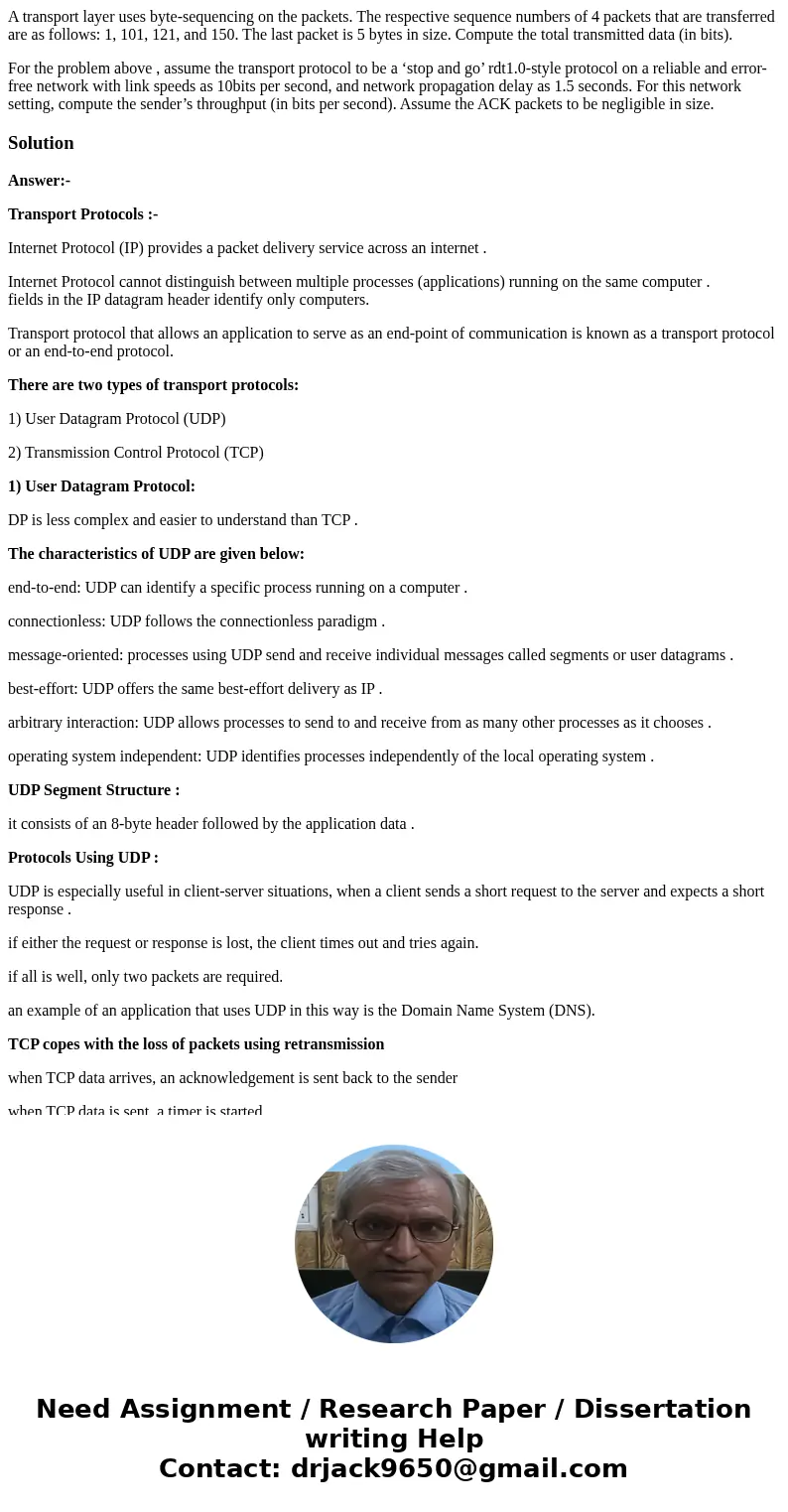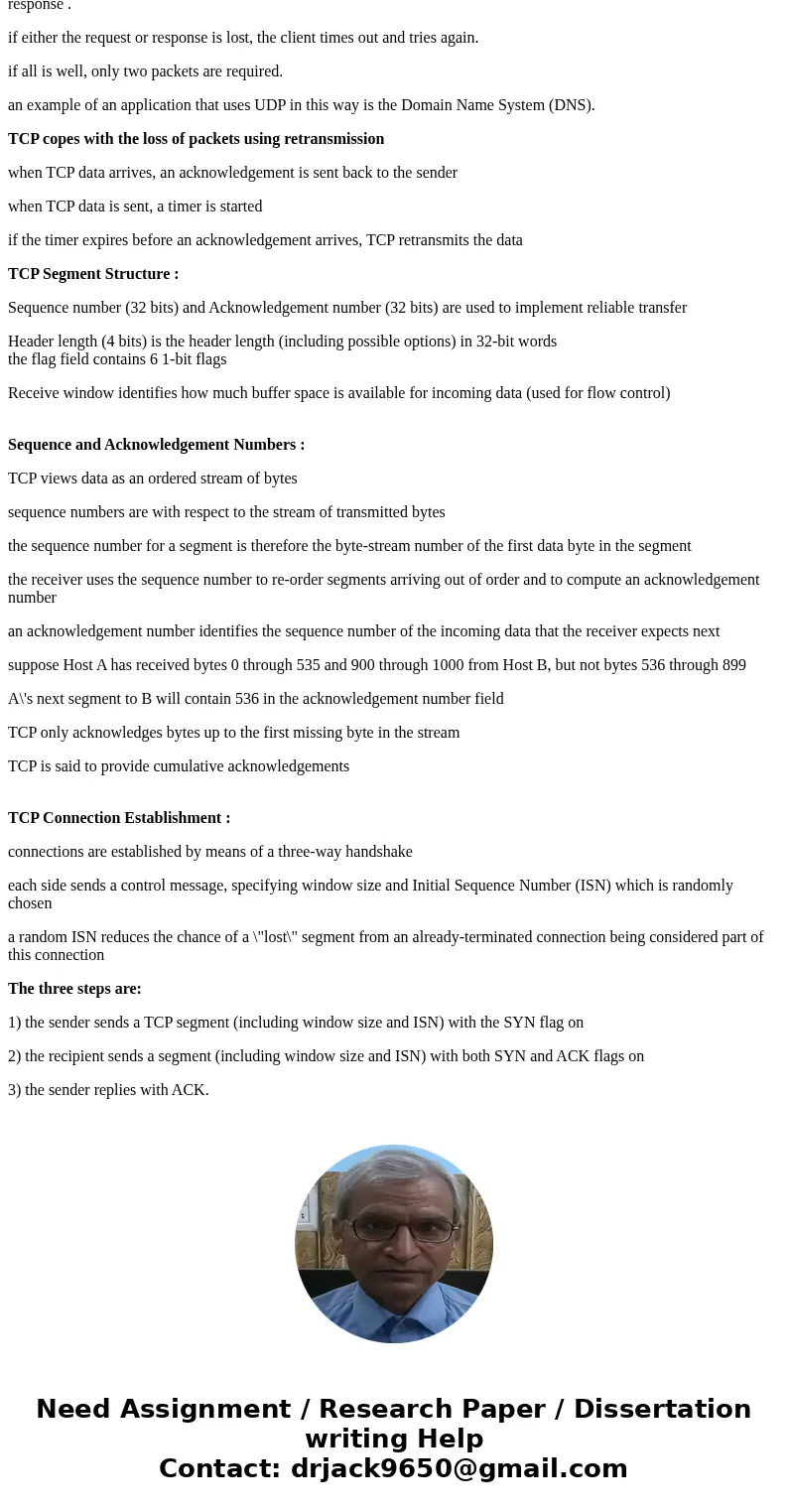A transport layer uses bytesequencing on the packets The res
A transport layer uses byte-sequencing on the packets. The respective sequence numbers of 4 packets that are transferred are as follows: 1, 101, 121, and 150. The last packet is 5 bytes in size. Compute the total transmitted data (in bits).
For the problem above , assume the transport protocol to be a ‘stop and go’ rdt1.0-style protocol on a reliable and error-free network with link speeds as 10bits per second, and network propagation delay as 1.5 seconds. For this network setting, compute the sender’s throughput (in bits per second). Assume the ACK packets to be negligible in size.
Solution
Answer:-
Transport Protocols :-
Internet Protocol (IP) provides a packet delivery service across an internet .
Internet Protocol cannot distinguish between multiple processes (applications) running on the same computer .
fields in the IP datagram header identify only computers.
Transport protocol that allows an application to serve as an end-point of communication is known as a transport protocol or an end-to-end protocol.
There are two types of transport protocols:
1) User Datagram Protocol (UDP)
2) Transmission Control Protocol (TCP)
1) User Datagram Protocol:
DP is less complex and easier to understand than TCP .
The characteristics of UDP are given below:
end-to-end: UDP can identify a specific process running on a computer .
connectionless: UDP follows the connectionless paradigm .
message-oriented: processes using UDP send and receive individual messages called segments or user datagrams .
best-effort: UDP offers the same best-effort delivery as IP .
arbitrary interaction: UDP allows processes to send to and receive from as many other processes as it chooses .
operating system independent: UDP identifies processes independently of the local operating system .
UDP Segment Structure :
it consists of an 8-byte header followed by the application data .
Protocols Using UDP :
UDP is especially useful in client-server situations, when a client sends a short request to the server and expects a short response .
if either the request or response is lost, the client times out and tries again.
if all is well, only two packets are required.
an example of an application that uses UDP in this way is the Domain Name System (DNS).
TCP copes with the loss of packets using retransmission
when TCP data arrives, an acknowledgement is sent back to the sender
when TCP data is sent, a timer is started
if the timer expires before an acknowledgement arrives, TCP retransmits the data
TCP Segment Structure :
Sequence number (32 bits) and Acknowledgement number (32 bits) are used to implement reliable transfer
Header length (4 bits) is the header length (including possible options) in 32-bit words
the flag field contains 6 1-bit flags
Receive window identifies how much buffer space is available for incoming data (used for flow control)
Sequence and Acknowledgement Numbers :
TCP views data as an ordered stream of bytes
sequence numbers are with respect to the stream of transmitted bytes
the sequence number for a segment is therefore the byte-stream number of the first data byte in the segment
the receiver uses the sequence number to re-order segments arriving out of order and to compute an acknowledgement number
an acknowledgement number identifies the sequence number of the incoming data that the receiver expects next
suppose Host A has received bytes 0 through 535 and 900 through 1000 from Host B, but not bytes 536 through 899
A\'s next segment to B will contain 536 in the acknowledgement number field
TCP only acknowledges bytes up to the first missing byte in the stream
TCP is said to provide cumulative acknowledgements
TCP Connection Establishment :
connections are established by means of a three-way handshake
each side sends a control message, specifying window size and Initial Sequence Number (ISN) which is randomly chosen
a random ISN reduces the chance of a \"lost\" segment from an already-terminated connection being considered part of this connection
The three steps are:
1) the sender sends a TCP segment (including window size and ISN) with the SYN flag on
2) the recipient sends a segment (including window size and ISN) with both SYN and ACK flags on
3) the sender replies with ACK.


 Homework Sourse
Homework Sourse